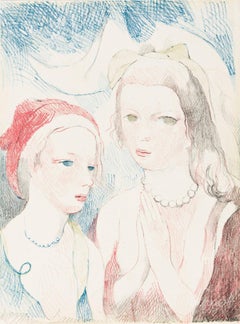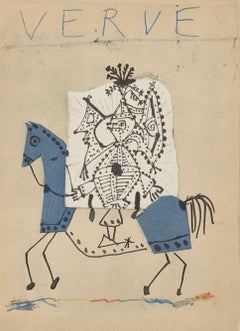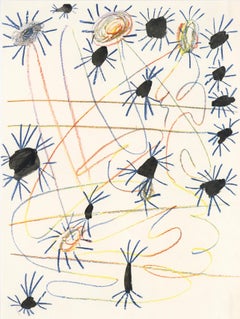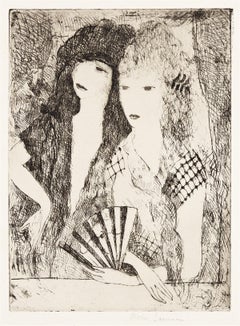Marie Laurencin Abstract Prints
Artist Marie Laurencin is best known for her enchanting portraits of women and young girls. The Parisian artist was linked to the avant-garde Cubist movement, but she endeavored to disassociate herself from the style as she instead drew on the Impressionist style of Pierre-Auguste Renoir in her paintings and prints, and created poetic, overtly sensual images of women in Fauvism’s subdued pastels at a time when the leagues of male artists around her became famous for making still lifes.
Just as Renoir and other painters began their careers painting pottery in Limoges, Laurencin trained in porcelain painting in the southwestern suburbs of Paris before she studied oil painting at Académie Humbert alongside influential Cubist painter Georges Braque and French designer and painter Francis Picabia. Her circle consisted of widely known and reputable artists including Braque and Pablo Picasso, with whom she exhibited. Her romantic partners were both male and female over the years, and she repeatedly refused marriage proposals from the most famous art dealer at the time, Sir Joseph Duveen, Baronet. Laurencin had a romantic relationship with French poet Guillaume Apollinaire that lasted six years.
Laurencin produced most of her best known work throughout the 1920s. During this era, she worked with art dealer Paul Rosenberg although she frequently ignored his business advice. Known to only paint children she liked, Laurencin also charged men twice that of women, as well as brunettes more than blondes, and offered discounts for works she enjoyed doing and steeper prices for those she cared less for.
Laurencin’s work increasingly attracted attention over time — she had more than ten solo exhibitions in 1939 alone and was commissioned for portraits by the likes of Jean Cocteau and Coco Chanel. (Revered fashion designer Karl Lagerfeld — who consistently displayed a knack for synthesizing old and new, high and low — drew on the work of Laurencin in his Spring/Summer 2011 collection for Chanel.)
Laurencin’s six illustrations of "Alice" in a 1930 edition of Lewis Carroll's Alice in Wonderland comprise a small sample of the art she made that is held in the public collection of the Museum of Modern Art. Her works are also held in the collections of the Metropolitan Museum of Art, the Musée d’Orsay and the National Museum of Women in the Arts. In 1983, a museum opened in her honor — the Musée Marie Laurencin in Nagano, Japan. At the time, it was the only museum in the world to focus solely on a female painter.
Find original Marie Laurencin paintings and prints on 1stDibs.
1920s Cubist Marie Laurencin Abstract Prints
Color, Drypoint, Etching
1940s Cubist Marie Laurencin Abstract Prints
Color, Lithograph
1950s Cubist Marie Laurencin Abstract Prints
Lithograph
1950s Cubist Marie Laurencin Abstract Prints
Lithograph
Mid-20th Century Cubist Marie Laurencin Abstract Prints
Lithograph
1950s Cubist Marie Laurencin Abstract Prints
Lithograph
1960s Cubist Marie Laurencin Abstract Prints
Lithograph
1980s Abstract Expressionist Marie Laurencin Abstract Prints
Drypoint, Etching, Aquatint, Intaglio
Mid-20th Century Cubist Marie Laurencin Abstract Prints
Lithograph
1950s Cubist Marie Laurencin Abstract Prints
Lithograph
1960s Cubist Marie Laurencin Abstract Prints
Lithograph, Stencil
1950s Cubist Marie Laurencin Abstract Prints
Lithograph
21st Century and Contemporary Pop Art Marie Laurencin Abstract Prints
Drypoint, Aquatint
1940s Cubist Marie Laurencin Abstract Prints
Drypoint, Etching, Aquatint
1920s Cubist Marie Laurencin Abstract Prints
Etching
Marie Laurencin abstract prints for sale on 1stDibs.
Artists Similar to Marie Laurencin
- 1stDibs ExpertJanuary 19, 2025Marie Laurencin is famous for being an artist. She is best known for her enchanting portraits of women and young girls. The Parisian artist was linked to avant-garde Cubism, yet she endeavored to disassociate herself from the movement. She instead drew on the Impressionist style of Pierre-Auguste Renoir in her paintings and prints and created poetic, sensual images of women in Fauvism’s subdued pastels. Find a collection of Marie Laurencin art on 1stDibs.




